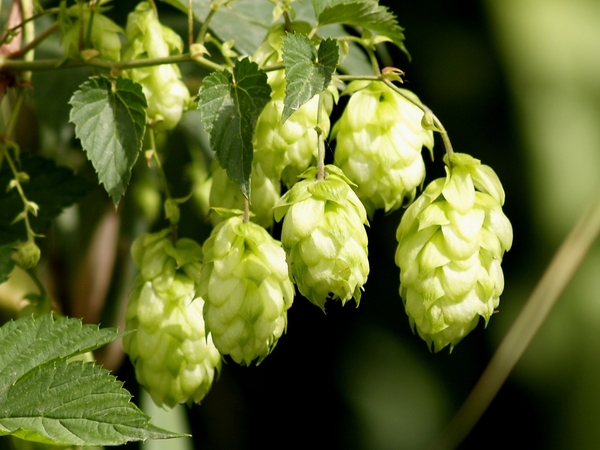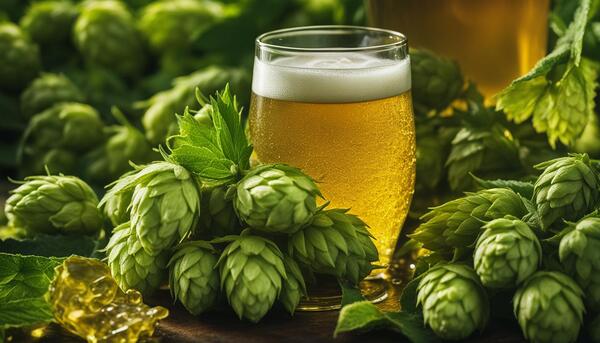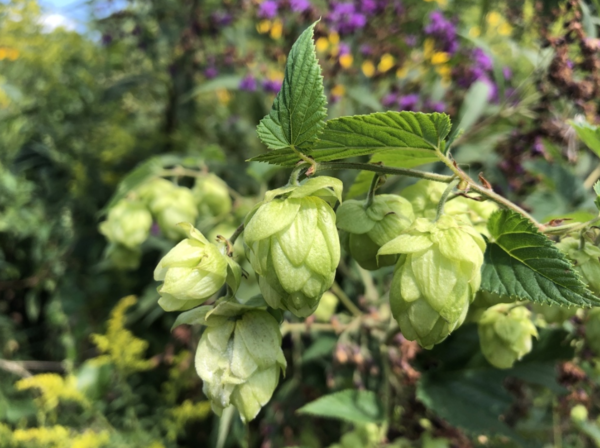Common hop (Humulus lupulus) is more than just the key ingredient in your favorite beer; it’s a plant with a rich history, diverse uses, and distinct characteristics. From its role in brewing to its medicinal benefits, hops have carved a special place in both industry and traditional medicine. Let’s dive into the world of hops, examining its features, habitats, value, and even its conservation status.

The common hop is a climbing, perennial plant that belongs to the Cannabaceae family. It’s best known for its distinctive cones (called strobiles) that are used in beer brewing. These cones contain bitter compounds and aromatic oils, essential for giving beer its characteristic bitterness and fragrance.
Key features:
Growth habit: Common hop is a climbing vine that can grow up to 6 meters (20 feet) in height. It uses tendrils to cling to trellises or surrounding plants for support.
Leaves: The plant has palmate leaves, meaning they are hand-shaped with multiple lobes. These leaves are rough on the upper side and have a softer, more downy texture on the underside.
Flowers: The hop plant is dioecious, meaning male and female flowers grow on separate plants. The female flowers form the cone-like structures (hop cones), which are harvested for brewing.
Color: The flowers (cones) can range in color from green to yellow, and they have a distinct, resinous smell, which is a characteristic feature of the plant.
Common hop belongs to the Humulus genus, but there are a few other species in this genus that are often confused with it, notably the Japanese hop (Humulus japonicus) and the Chinese hop (Humulus chinensis).
Humulus japonicus: Also known as Japanese hop, this species is often used for ornamental purposes and can be found growing wild in Asia. While similar in appearance, Japanese hops are generally less aromatic and not used in brewing.
Humulus chinensis: This species is commonly found in China and other parts of Asia. It is more commonly used for medicinal purposes in some regions, although it is less bitter than Humulus lupulus and doesn’t have the same brewing potential.
The key difference lies in the chemical composition of the cones, particularly the levels of humulone (a bitter acid) and essential oils, which are higher in Humulus lupulus and essential for brewing.
The native range of common hop spans across Europe, Western Asia, and North America. In the wild, hops can be found in temperate forests and along riverbanks, where they prefer moist, well-drained soils.
Common hop is known to thrive in regions that have a cool climate with plenty of sunshine, though it’s fairly adaptable to different environments. It’s generally found growing at altitudes of 400-1500 meters in mountainous regions in China and other parts of the world.
Soil: Hops thrive in well-drained, slightly acidic soils with a pH level between 6.0 and 6.5.
Climate: While hops are tolerant to dry conditions, they do best in areas with moderate rainfall and cool temperatures. Ideal growing temperatures range between 18°C to 25°C (64°F to 77°F). High temperatures above 35°C (95°F) can limit growth, and severe frost can damage the plants.
Hops require full sun exposure to produce the best yields, and they are quite sensitive to light. They need around 14 to 17 hours of sunlight a day to thrive and produce good-quality cones.

Brewing: The primary value of the common hop is its use in the brewing industry. It is a critical component in the brewing of beer, where it contributes to the bitterness, flavor, and aroma of the beverage. Hops are added to the brewing process to balance the sweetness of malt with their bitterness, and their essential oils provide complex floral, citrusy, earthy, and piney aromas. The amount of bitterness and aroma varies depending on the hop variety used, making it a highly versatile ingredient in different styles of beer.
Medicinal Uses: Historically, hops have been used in traditional medicine. They are known for their sedative properties, which are beneficial in treating anxiety, insomnia, and stress. In addition, hops are also used in the treatment of digestive disorders and inflammation due to their anti-inflammatory and antioxidant properties.
Ecological Value: Beyond brewing and medicinal uses, hops are ecologically important as they provide food and habitat for a variety of wildlife, including insects and small mammals. The dense canopy created by hop vines can also help prevent soil erosion in some environments.
While common hop is not currently considered endangered, there are a few threats to its cultivation and wild populations.
Climate Change: Changes in temperature and precipitation patterns are disrupting hop cultivation, especially in regions where consistent weather is crucial for a good harvest. Warmer climates may hinder the growth of hops, and extreme weather events, such as droughts and floods, can reduce yields.
Over-exploitation: Due to the increasing demand for hops in the brewing industry, there has been intensive farming of hops in certain regions, leading to soil depletion and reduced genetic diversity. This monoculture farming can make hop plants more susceptible to diseases.
Habitat Destruction: In some parts of the world, the natural habitats of wild hops are being destroyed due to deforestation and urbanization, which limits their ability to grow in the wild.
Sustainable Farming Practices: More breweries and hop farms are turning to sustainable farming methods, such as organic farming and agroforestry, to preserve soil health and biodiversity.
Research and Breeding: There is increasing interest in breeding hop varieties that are more climate-resistant, disease-resistant, and capable of growing in a wider range of environments.
Protected Areas: In some regions, efforts are being made to protect wild hop populations by establishing protected areas and promoting the restoration of habitats.
While the IUCN (International Union for Conservation of Nature) currently classifies the common hop as Least Concern (LC), the threats posed by climate change, agricultural practices, and habitat destruction mean that we must be vigilant about its future. Hops are not considered in immediate danger, but it is essential to continue monitoring their conservation status to ensure sustainable cultivation and biodiversity.

The history of the common hop is as rich as its role in brewing. Hops have been used in brewing beer since the 9th century in Europe, where they were believed to add stability and preservation properties to beer. The use of hops in brewing likely began in Germany and spread throughout Europe during the Middle Ages.
Over time, hops became the defining ingredient in beer-making, especially after the invention of the lager style in the 15th century. By the 17th century, hop cultivation spread to North America and other parts of the world, where it became a staple crop for brewing.
Today, hops are grown in regions worldwide, with major producers including Germany, the United States (particularly the Pacific Northwest), and New Zealand. Hop cultivation has evolved, with farmers focusing on developing new varieties that offer unique flavors and aromas for modern craft beer.
In conclusion, common hop (Humulus lupulus) is a fascinating plant with deep roots in history, culture, and agriculture. Whether you’re enjoying a cold craft beer or learning about its medicinal benefits, hops have a special place in the world. As we continue to face environmental challenges, it’s essential to preserve this invaluable plant and ensure that its future remains as bright as the beer it helps create.
animal tags: common hop
We created this article in conjunction with AI technology, then made sure it was fact-checked and edited by a Animals Top editor.